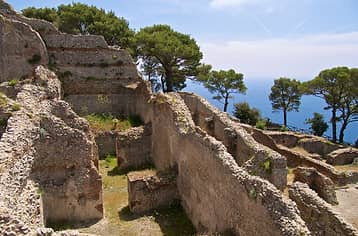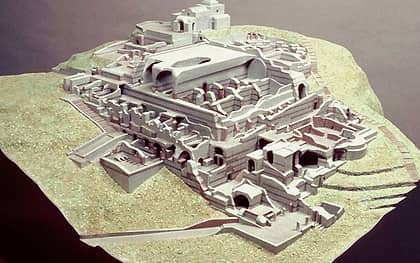Villa Jovis





Visiting Villa Jovis
Villa Jovis is situated at the end of Viale Amedeo Maturi, where one finds a number of steps faced with marble slabs originating from the Roman Villa. Villa Jovis, built in the first century B.C. and attributed to Tiberius, was chosen for its position on the cliff's edge which guaranteed both privacy and security, of vital importance to the Emperor.
Getting there: From the Piazzetta, walk the length of Via Longano, continuing along Via Sopramonte and finally Via Tiberio. It's an uphill walk and will take about 45 minutes.
Ticket price: Euro 6,00; free for European Union citizens under 18. Tickets can only be paid by credit card and debit card.
Current opening & Hours:
January and February
Closed
March
10 am - 4 pm, only on Saturday and Sunday
April
10 am - 4 pm
May
10 am - 6 pm
June to September
10 am to 7 pm
October
10 am to 5 pm
November and December
10 am to 4 pm
Last entrance: 30 minutes prior to closing time
Closed on Mondays
A considerable percentage of the Roman villa remains, a villa which was built with large cisterns and water tanks, so as to counteract the perennial lack of water on the island of Capri. Villa Jovis was organized in sections linked by corridors, stairs and passageways. The Emperor had a North facing apartment with views over the Gulf of Naples; to the East there was the section dedicated to official functions; the baths were to the South and to the West the servants accommodation and lavatories were located. Tiberius's Villa extended over 5.500 square meters and was built up on various levels, unusual for the period, but made necessary by the location.
At the end of the avenue which leads to the villa there is the famous "Tiberius's Leap", place where, according to local legend, disobedient servants and undesired guests were hurled over the cliff by order of the Emperor. The furnishings and decorative features have been gradually removed over the centuries; placed in museums or used to decorate Royal palazzo, with some materials, such as the marble paving, even sold by weight.
The Villa Jovis complex was officially inaugurated in 1937, after excavation work carried out by the Archaeologist Amadeo Maiuri following strict scientific criteria. Within the site boundaries of Villa Jovis one finds the small Church of Santa Maria del Soccorso. In the space in front of the church there is a statue of the Madonna, visible from the sea below.
The simplest route to Villa Jovis
From Piazza Umberto I (Piazzetta di Capri) take Via Le Botteghe, followed
by Via Fuorlovado, Via Croce and Via Tiberio.
Combine Parco Astarita and Villa Lysis
An insider tip! The route to Villa Jovis takes a bit of time and effort, so it's nice to break it up by adding two stops along the route: Parco Astarita and Villa Lysis. This way you can make the most of your time and avoid getting too tired out along the walk.
Before entering Villa Jovis, take a moment to wander through the beautiful but little-known Parco Astarita, which is free to the public. It's worth the stop if only to take in the view from the final terrace of the park, which is truly breathtaking. You will also run into the wild goats which roam free on Capri's hillsides during your walk.
Afterwards, stop at the lovely Villa Lysis, the historic residence built by Count Fersen during his exile on Capri.
Top Hiking and Walking Trails in Capri.
Information
The opening hours of Villa Jovis, Parco Astarita and Villa Lysis change frequently, so before you plan on visiting, we suggest double-checking to make sure it’s open by asking at the tourist information offices in the Piazzetta or Marina Grande'''.





FAQ - Frequently asked questions
Villa Jovis: hours, tickets and prices
Getting there: from Piazza Umberto I, along Via Le Botteghe, Via Fuorlovado, Via Croce and Via Tiberio, or, again from Piazza Umberto I, along Via Longano, Via Sopramonte and Via Tiberio.
Walking time from Piazzetta: 45 minutes uphill (be sure to wear comfortable shoes).
Ticket price: EUR 6; EU citizens under 18 years: free. Tickets can only be paid by credit card and debit card.
Opening & Hours: from Thursday to Sunday, at the following times:
10:00 a.M. -7:00 p.M. June, July, August, September
10:00 a.M. - 6:00 p.M. April, May and October
10:00 a.M. - 4:00 p.M. March, November and December.
Notes: Closed on December 25th, in January and February. The opening hours of Villa Jovis are always very variable: before setting out, we recommend that you consult the tourist information office in the Piazzetta or Marina Grande for safety.